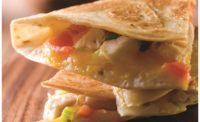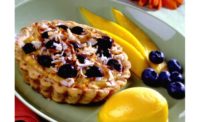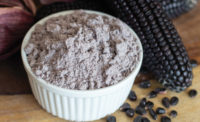Ever since Americans became aware of the negative effects gluten can have on a very small minority of the population, they’ve been turning to websites, blogs, TV and other media for information about gluten-related health issues and gluten-free diets. They’ve also been asking their local grocers to carry more gluten-free products, including baked goods and snacks.
Shoppers now have a wider selection of gluten-free products from which to choose, while retailers and manufacturers are enjoying increased sales. According to new research published by Mintel on Dec. 4, 2015, the gluten-free foods category experienced growth of 136 percent from 2013–2015, reaching estimated sales of $11.6 billion in 2015.
But David Sheluga, director, consumer insights, Ardent Mills, Denver, says this figure is actually much lower. “Our estimate for 2015, based on our gluten-free definition, is $1.3 billion,” he explains. “A year ago, it was $1.1 billion, so we’re talking 14 percent growth, but that growth is decelerating.”
Sheluga explains that Ardent Mills uses Nielsen data for the U.S. to compile its sales analysis. His company’s definition of gluten-free encompasses products where wheat is substituted, such as breads and baked goods. Products must be made by a manufacturer committed to gluten-free. Products must have a clear gluten-free claim on the front of their package, and the claim must be prominent or primary.
Shelugae notes that growth has been cut in half each year since 2012. “When growth is cut in half each year, that’s a sign of a maturing category and, generally, it follows that pattern each successive year,” he says. “So you could predict that 2016 might have 7 percent growth. We’re looking at a category that hasn’t quite plateaued, but it’s moving in that direction.”
Healthier products
Despite a possible slowdown in gluten-free product sales, manufacturers will continue to launch new gluten-free products in the coming year. Many health-conscious consumers with no dietary issues are seeking out products made with ancient grains like quinoa, amaranth and sorghum, which also are appearing in gluten-free goods.
“Quinoa, amaranth, millet, teff, sorghum and rice-based solutions—the whole seed, as well as flours—tend to be where Ardent plays best in the gluten-free ingredient arena,” says Peter Asta, R&D manager, Ardent Mills. “We also offer blends and custom blends of those in various formats. They’re mainly used in traditional foods forms, from the snack arena to the fresh bread arena, and sometimes even as toppings.” He adds that the company has been receiving more requests for hot cereals and porridges, good vehicles for ancient grains.
“We find that the gluten-free community does appreciate staple, grain-based foods, such as bread, tortillas, pasta and indulgences, that are similar to their wheat-based counterparts,” says Vanessa Brovelli, senior product applications technologist, Bay State Milling Co., Quincy, MA. “However, a health-conscious, gluten-free consumer also tends to be looking for more than texture and taste, like better nutrition and claims such as organic, natural, non-GMO and clean-label. Starch- and gum-based formulas are being upgraded with whole grains and seeds, which provide much-needed doses of fiber and protein, as well as vitamins and minerals.”
Bay State Milling offers a variety of grains, seeds, flours and flour blends for use in gluten-free baked goods, such as quinoa, amaranth, sorghum, buckwheat, teff, non-GMO corn, rice, flax, chia, pumpkin seed, sesame seed, sunflower seed and garbanzo flour. The company’s GF Flex Flour and GF Flex Whole Grain Flour can be used to replace the flour portion of a formula, while its complete gluten-free baking mixes incorporate whole-grain flours and functional ingredients suited for specific applications, such as bread, flatbread, pizza crust, cookies, muffins and cake.
Freya Ivory, brand manager, BFree Foods Ltd., Los Angeles, says: “Gluten-free bakery has a reputation for being very poor nutritionally, bad-tasting and subpar performance-wise. Some gluten-free bread producers use egg to replicate the structure of gluten, which can give break a cakelike taste and texture—not to mention all the fat and sugar those companies use.” BFree has developed recipes using pea protein and apple fiber to replace the structure of gluten, an approach that also makes the breads, rolls, bagels and wraps suitable for vegans.
Ashland Specialty Ingredients, Wilmington, DE, is also seeing strong demand for higher-quality gluten-free goods. “Consumers are not satisfied with gluten-free solutions of the recent past and are expecting textures and qualities more comparable to the traditional wheat flour products,” says Mark Hines, Ph.D., global program manager, food R&D and technical services for the company.
Hines says the company’s Benecel line of hydroxypropyl methylcellulose (HPMC) is an effective addition to a majority of gluten-free applications, including bread and pizza crust. Its Aqualon carboxymethylcellulose (CMC) is effective in some products, including gluten-free doughnuts, brioche, muffins and pretzels. “We see an equal use of HPMC and CMC in many of the sweet, gluten-free applications, depending upon the process, regional markets and base formulation,” he notes. Both are sustainably sourced from the natural cellulose in plants and modified for unique functionality. HPMC is GMO-free, while many grades of GMO-free CMC are available.
BENEO Inc., Morris Plains, NJ, offers a range of rice ingredients, including starches, flours and protein, to improve the functionality of gluten-free products. “In gluten-free bread, rice flour enhances the crumb structure and volume, and thanks to its ability to promote water retention during the baking process, extends the shelf life and moistness of soft baked goods such as cakes,” says Jon Peters, president of the company. “For gluten-free soft baked goods like cakes and muffins, BENEO has developed a micronized native rice flour showing improved performance over standard milled flours. It eliminates the need of using a complex combination of multiple starch and flour types, keeping the ingredient list clear and simple.”
In addition, BENEO recently developed a recipe for gluten-free pizza dough containing rice flour and rice starch. The rice flour produces nonsticky dough and improves the crust’s crispness. The rice starch makes the dough flexible and cohesive.
Healthier lifestyles
Some consumers don’t just view gluten-free products as part of a healthier diet, they see them as part of a healthier way of living, whether they have gluten sensitivities or not.
“Once considered a micro trend, ‘gluten-free’ has become firmly entrenched in consumers’ minds as ‘good for you,’” says Peters. “Consequently, gluten-free is not a trend anymore, but a lifestyle. Health-conscious consumers who don’t have any intolerance or allergy issues are increasingly likely to choose gluten-free products, seeing them as healthier alternatives to gluten equivalents.”
Ricardo Rodriguez, marketing manager, confectionery & bakery, Ingredion Inc., Bridgewater, NJ, believes growth within gluten-free will be driven by consumers wanting to make healthy lifestyle choices. “Based on IRI numbers, the category grew by 20 percent in 2014 and has a compound annual growth rate of 19.2 percent for 2014–2019,” he says. “This growth will continue to be supported by consumers without dietary issues. These are the consumers that are making a lifestyle choice to eat healthier and are seeking out gluten-free products as part of this choice.”
Ingredion offers bulk flour systems, bulk flour components and texturizers in a wide range of base materials, including tapioca, potato, rice, corn, hydrocolloid gums and pulses, along with fibers and proteins. Its HOMECRAFT Create GF 10 and 20 bulk flour systems, PRECISA Bake GF texturizing system and the PENTECH GF starch system provide customers with functional solutions to create a wide array of gluten-free baked goods with the texture and product quality of gluten-containing products.
The company’s new pulse-based ingredients—pulse flours under the HOMECRAFT brand and pulse-based proteins—are designed to provide added protein and fiber. The flours are available from a variety of sources—yellow pea, yellow lentil, fava bean, red lentil and chickpea—and are non-GMO, hypoallergenic, low-fat and low-glycemic.
“Greater access to information has driven, and will continue to drive, many consumers to prefer gluten-free options, including a health-conscious young generation that wants to protect itself against some lifestyle health risks associated with lack of informed feeding options,” says Flint Williams, director of bakery sales, Solvaira Specialties, North Tonawanda, NY. The company offers a customized, gluten-free flour blend for tortillas, pizza and pita chips. It features functional leavening agents, fibers, preservatives, emulsifiers, dough conditioners, gums, acidulants, sweeteners and enzymes for soft, pleasantly textured, visually appealing goods that stay pliable during storage.
Where it all began
Even if consumers seeking healthier lifestyles no longer buy gluten-free products, there still are people with dietary issues who will.
“The presence of non-celiac gluten sensitivity—a condition that has similar gastrointestinal symptoms of celiac disease—is gaining recognition among consumers,” says Colleen Zammer, director of product marketing, Bay State Milling. “This condition affects approximately 6 percent of the population, a much greater number of consumers seeking solutions than those with celiac disease, which may be driving growth within the category.”
Brovelli says some manufacturers are also targeting consumers who are more sensitive to foods and ingredients that are known allergens, such as eggs, dairy and even FODMAPS (fermentable oligo-di-monosaccharides and polyols).
“While there is certainly a ‘fad diet’ aspect of the gluten-free market that we believe will fade, overall the market should remain viable due to the number of people with celiac disease, wheat allergies or gluten sensitivity,” notes Julie Pizzey Faber, marketing & compliance, Pizzey Ingredients, Russell, Manitoba.
Pizzey Ingredients supplies a full line of gluten-free flaxseed products known as PurFlax that includes BlendPur and BakePur, both of which can be used as gluten-free flour replacements. “We have also had great success using BlendPur as a one-to-one replacement for xanthan and guar gum in gluten-free baking applications, which provides both a cost savings and a cleaner label for manufacturers,” Faber adds. “BakePur is more appropriate for use in whole-grain applications where a coarser texture is desired.”
Jennifer Tesch, chief marketing officer, Healthy Food Ingredients LLC, Fargo, ND, says: “I think more people are being correctly diagnosed with dietary issues, where previously these health concerns had not been properly diagnosed.” Manufacturers use the company’s pulses, seeds, ancient grains and whole, raw and milled corn, as well as other ingredients, in baked goods, snack foods, baking mixes and more.
“With the recent addition of Suntava to Healthy Food Ingredients’ family of brands, we are now able to offer Suntava purple corn for use in functional foods,” says Tesch. “The Suntava purple corn is certified gluten-free through NSF.”
Kim Holman, director of marketing, Wixon Inc., St. Francis, WI, says: “Many people just feel better on a gluten-free diet and are going to continue this as a life-style choice. This is really why gluten-free will hang around. The trend may be peaking, as almost all research firms are declaring, and it’s peaking because eliminating gluten doesn’t cure everything.
“In the end, consumers will decide if gluten-free stays or goes,” Holman continues. “They will speak with their wallet. In the meantime, companies need to stay in touch with their customers and understand their changing needs around gluten-free.”













